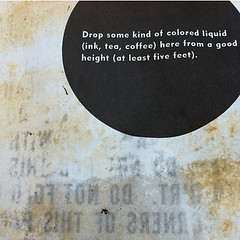1 Art
I’m a sucker for a good juxtaposition. So, apparently, is photographer Richard Renaldi. The images in Renaldi’s “Touching Strangers” project do what juxtaposition does best: startle the viewer into looking at things a different way. In the project, he photographs strangers together, touching in ways that are markedly intimate, he manages to momentarily transcend complex social barriers and create an intensely human connection. New York Times: Lens features a number of the images and explores the difficulty Renaldi encountered seeking out an Orthodox Jewish man to pose for a portrait with an African American. Picture Correct includes this video of Renaldi discussing the project and arranging for a shoot with Jessie, an elderly woman. See the full collection of poignant images in Renaldi’s “Touching Strangers” gallery online.
It’s a different sort of street photography to be sure. The hundred thousand or so photographs taken by nanny Vivian Maier and acquired at auction by John Maloof in 2007 held a treasure no one would have expected.
The photos are an outstanding catalogue of urban American life… highlighting everyday mundanity, strangers glamorous and rugged alike, and—inadvertently—fashion of the time. We can’t help but admire her subjects’ perfectly coiffed hair, fur shawls, birdcage veils, and pearls. Beyond this, her black-and-white collection is a time capsule of moments that are beautiful for their normalcy: families on street corners, children playing, and lovers whispering.
Maloof’s documentary on the curious figure behind the lens is due out in 2014. (Elle)
And while we’re talking about street art, let me add this little tiny piece about Spanish artist Isaac Cordal’s miniature people, Cement Eclipses. Please, watch your step out there. (Twisted Sifter)
2 News
The other day I heard a man in his 80s express his disappointment to a restaurant server by saying “Bummer, man.” He sounded mildly awkward, but was completely sincere in his use of the phrase which, if I remember correctly, inserted itself into teenage vernacular when I was in junior high. Language evolves very slowly–sometimes over a few hundred years, and may not be noticeable for another several decades. But large collections of digital text now make it easier to track and analyze those changes. It’s kind of like time-lapse photography for language. Take a look at these four subtle shifts in the English language that you might otherwise miss.
In case you keep up on this sort of drama, there’s been another scathing attack on the state of poetry. In this case, apparently, it’s only American verse that’s called on the carpet. Well, American verse plus beloved Irish poet Seamus Heaney, just to be clear. And as you know, every attack on poetry must be answered. You can read the assault at Harper’s (if you subscribe), or you can skip ahead to the latest response at Slate (for free). Or, you know, you could save yourself the trouble and just go stand in the alley behind your house and listen to the neighbor kids, where you’ll hear something, I’m sure, about whose dad can beat up whom and probably something about somebody else’s mother’s footwear and its suitability for armed combat.
If you want to switch to more substantive discussions, you might check NPR, where they have reported that the Twinkie, which returns to your friendly neighborhood grocery this month, has doubled its shelf life. The shiny, cream-filled golden snack food played a prominent role in the poem that nudged my poetry out into the open, so I’m all for Twinkie the Kid having a better than average life expectancy. The Twinkie is dead! Long live the Twinkie!
Finally, for those of you who love summer camp and Pride and Prejudice, we regret to inform you that you missed the first annual Jane Austen Summer Program at the University of North Carolina (known by insiders as “Jane Austen summer camp”). Don’t worry, Ted Scheinman of the Paris Review covered the event with a series of Austen-level action-packed diary entries. For example, from June 28:
11:15 A.M. Following little sleep and generous helpings of fruit, I chair the panel on “Jane Austen and Romance, ” with excellent papers from Sarah Frantz, Kumaraini Silva, and Emma Calabrese. (At the current rate, Colin Firth will set a record for most appearances in Microsoft PowerPoint before the weekend is up.) My task is to introduce each panelist and then drag her from the lectern as gently as possible once her time is up. Professor Inger Brody has provided me with three large laminated signs: “FIVE MINUTES”; “TIME TO STOP”; and my favorite, “YOU’VE DELIGHTED US LONG ENOUGH, ” a quotation from that uncomfortable scene in which Mr. Bennet must separate his bespectacled, strident-singing daughter Mary from the piano forte. For all the genial wit, these signs prove less useful than, say, a shepherd’s crook, which would have been more direct.
I didn’t want to mention this, but since we’re talking about Pride & Prejudice, please tell me you overlooked news of the gigantic Mr. Darcy emerging from the lake? You needn’t go look. I’m telling you. (Melville House)
3 Places
We’re fans of the literary tour around here. We love visiting places of artistic and writerly significance, and we love hearing about them. Flavorwire has a list of 50 places every literary fan should visit. I’m far from hitting all 50, but I was happy to be able to check off two sites (the Emily Dickinson homestead and Edith Wharton estate). I plan to double my count in the near future. I did feel a twinge of regret over not having visited the former of home of Jorge Luis Borges on one of my trips to Buenos Aires (though in my defense, I was still bitter over those Spanish lit classes I failed). To make up for it, how about I promise to hit F. Scott Fitzgerald’s birthplace in St. Paul next time I visit my parents? And I should get bonus points for visiting the Laura Ingalls Wilder homestead in the dead of winter, but poor Laura didn’t make the top 50 cut. (Flavorwire)
Maybe you don’t want to travel. You’d just like to get dinner. Might we suggest you take a literary restaurant tour? Flavorwire is here to help with that too, offering ten book-themed restaurants for your dining and reading pleasure. I didn’t get a look at any of the menus but I’m wondering if any offer the Deep Fried Twinkie delicacy. (A potential use for your leftover Take Your Poet to Work Day popsicle sticks.)
4 Poetry at Work
“But what does it mean for a poem to be hard? Is it the same thing as when science is hard?” And is it the same thing as when a 46-day-old Twinkie is hard? (Except for the Twinkie part) that’s the question Adam Frank is asking about poetry and physics, most particularly T.S. Eliot’s The Waste Land and physics. Frank suggests they are hard in similar ways, notably the manner in which one comes to an understanding of the poem, or the physics:
In my own experience, for example, you do have to move in with a difficult piece of mathematical physics. It comes to you slowly. You read it, work out some details, get lost, come back again later. (NPR)
Rafael Campo, associate professor of medicine at Harvard, says “A good poem engulfs us, takes hold of us physically. Its concision and urgency demand the participation of another in order to achieve completeness, to attain full meaning. In these ways, it’s not so different from providing the best, most compassionate care to our patients.” Campo’s poem Morbidity and Mortality Rounds just won the Hippocrates Open International Prize for Poetry and Medicine. The poem explores death and the relationship between caregiver and patient with, yes, the precision of a scalpel, and demonstrates yet again the ways in which poetry can stand in where other means of expression fail. (Slate)
5 Creativity
I recently started a sketch-a-day practice which, in actual practice, looks more like a-sketch-on-some-days. But it’s good for me and has, in fact, joined the ranks of a short brisk walk in the park as an immediate stress reliever. I recently ran across this mesmerizing animation created by Denis Chapon, who did twelve sketches each day on the back of used sheets of paper (the effect of the back side of the paper showing through is wonderful). The finished animation is the result of three years of sketches.
We often talk about writing as work. (And it is.) But what if we looked at writing like going on vacation? What if we recognized that writing allows us to go places we’ve never gone, do things we’ve never done (or would never do), try foods we’ve never tried (like, say, Twinkies)? According to Caitlin O’Neil, that’s exactly what writing can be.
Feel like swearing like a longshoreman? Sleeping around? Seeing what it’s like to be a man? Well, maybe you can’t do those last few on vacation without repercussion, but you can on the page. Writing allows us the chance to leave habits and rules and labels behind, in the same way vacation lets us leave behind the routines and rhythms of our lives, the ones that dull our senses over time. We try new food, inhale some wood smoke, get a sunburn, skin a knee, and remember the varieties of experience the world has to offer. We return to our lives with new eyes. So too writing can offer us a creative escape from the parts of our lives that lull and dull. It forces us to see people, places, and motivations clearly. (Ploughshares)
6 Write-It
You know how we feel around here about reading a poem a day, right? (In fact, we’ve been known to dare people to read a poem every day and see what happens.) But what about writing a poem a day? And not just during National Poetry Month? Poet Luisa Igloria started writing a poem a day three years ago, now has a portfolio bulging with nearly 1000 poems and is publishing her first collection. Besides the wealth of poems she has to her credit, Igloria notes the practice has been helpful in her writing overall, saying she “no longer believes in writer’s block” but does recommend eating a Twinkie each day as part of a solid poetry-writing ritual.
I realized at any given time of day that I want to work, I can drop down fairly quickly into that space and not feel so much the artificial constraints – the laundry to do, grading, class preparation, a meeting tomorrow. When I decide I’m going to go work on writing, no matter how long or short a stretch, I can now tune out the noise.” (The News at Old Dominion University)
Yeah, okay. Maybe she didn’t say that about the Twinkie. But she didn’t say not to, either. So one can only assume.
7 Poems
Once upon a time, when I still ate Twinkies after school, I thought poetry was all about stringing words in a certain way that it would sound nothing like the way people actually talked. Rhyming and hop-a-long pentameter, that sort of thing. But I didn’t understand the way those words were strung along to create a powerful image that would carry through no matter if the poet had two left iambic feet. The images in Allison Seay’s Time of Need are that kind of image to me. The poet uses the thin arms, the heaving, the stained dress, the distance to speak of love in a way that makes sense to me.
Time of Need
that dog. Liliana was walking beside me awhile
(I am sure) and I was almost not crying but then foundwhat I was looking for.
She heaved it for me—all of it, the stench, the weight—
all the way home. Her dress was stained. This is howI learned about love. She did not mind at all
the silent, steady distance I placed between us.
8 People
Seems we spend a lot of our emotional, physical, and mental currency trying to stave off failure, though it is in so many ways inevitable. Why, even the Twinkie failed to keep Hostess afloat at such a crucial time. (Which brings up an interesting idea. I wonder if Twinkies would work as flotation devices in the unlikely event the aircraft would crash over water. And if that’s true, then why do airlines serve pretzels instead of Twinkies?)
We were discussing failure, yes? Margaret Atwood is one of seven writers featured in a recent Guardian piece on failure. Atwood reflects:
Failure is just another name for much of real life: much of what we set out to accomplish ends in failure, at least in our own eyes. Who set the bar so high that most of our attempts to sail gracefully over it on the viewless wings of Poesy end in an undignified scramble or a nasty fall into the mud? Who told us we had to succeed at any cost?
She goes on to say, “Get back on the horse that threw you, as they used to say. They also used to say: you learn as much from failure as you learn from success.” With all due respect to Atwood, and remembering my view of the horse from the ground, flat on my back, it might good to wait a day or two to remount.
9 Books
Didn’t get enough of the street artists in the first segment? Grab your coffee and Twinkie and come look at the brick wall with me. Penguin collaborated with 10 well known street artists to create new covers for classic books to give them an “urban edge.” I think I might like The Rime of the Ancient Mariner the best. Not that it convinced me I want to read it. (Design Taxi)

‘People disappear into their stories all the time, ‘ [Solnit] writes, inviting us to disappear into hers. We gladly do, since every careful sentence, every judicious image comprising chapters that take the reader forward and back into the nature of storytelling, is plenty alluring. It is her contention that making stories — something we are, anyway, helpless not to do — is an act both of creation and deception, of the self and of others (‘I am, we each are, the inmost of an endless series of Russian dolls; you who read are now encased within a layer I built for you, or perhaps my stories are now inside you’; ‘We think we tell stories, but stories often tell us, tell us to love or to hate, to see or to be blind’).
“The stories often tell us.” How could I not read a book that said something like that?
10 Sound ‘n Motion
Here’s what I love about this video featuring The Paper Kites: I love tin can walkie talkies. But there’s a little more, the simple idea that what appears should be the end of this story is not.
Photos by Claire Burge. Used with permission. Post by Will Willingham.
- Earth Song Poem Featured on The Slowdown!—Birds in Home Depot - February 7, 2023
- The Rapping in the Attic—Happy Holidays Fun Video! - December 21, 2022
- Video: Earth Song: A Nature Poems Experience—Enchanting! - December 6, 2022










Maureen Doallas says
Twinkies are the new Spam, no doubt.
Austen even gets to be on English currency.
Will Willingham says
I saw that! Seems like every time I write this column I come across a link that would have fit perfectly. 🙂
Anthony says
I’m reading Solnit now on the treadmill, and it’s very gorgeous. Well, not right now. Right now I’m off for a nap. Then, then I will get up and put some gym clothes on (nothing matching or scratchy) and go to the gym, turn on a treadmill, hop on, and continually fall forward while reading Solnit. Which is gorgeous.
And you too! For this wonderful work.
Will Willingham says
Ah, have the book in my hands now, but can’t read it until next week. Travel fare. And, I have too many things on my list that do not begin with “read a book.” So I must wait.
But glad to know I’m going to like it. 🙂
Elizabeth W. Marshall says
Wowza, this is so rich. The amount of time you spent pulling this together is….well not lost on me. It is fabulous.
I just came from visiting Thomas Wolfe’s childhood home in Asheville “My Kentucky Home”. My heart is still beating fast, the experience was so moving. Much more than I expected. And I have wonderful pictures. I took my mother who has dementia and she was over the moon with every moment of the tour.
Seems I am writing of her a lot these days. Sorry to bore you all at TS with it.
You mention above the poet writing a poem a day. I am going to attempt that. I may let you know one day how it went.
Thank you for these extreme offering for us folks on the other side of the screen.
Will Willingham says
No apology needed for that; not boring us at all. Happy for the times you’re having together.
I tried writing a poem a day last year during Natl. Poetry Month. It was a good practice. Wrote some terrible poems. But I wrote poems, and that was good for me. 🙂
L. L. Barkat says
I love that video. The string. So much feeling in that simple object and how they interact with it. And? The way it didn’t end where expected. Yes, that too.
Goodness me. The Twinkie Edition? Where is Maureen’s Twinkie poem to honor the occasion? 😉